|
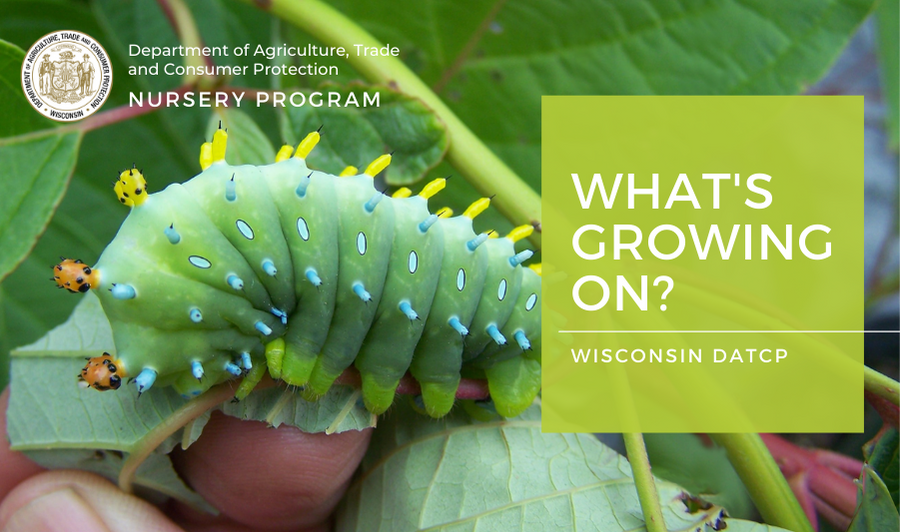 _____________________________________
Dear Wisconsin nurseries, Christmas tree growers, and gardeners:
As the active growing season winds down, the treatment windows for active pests and diseases are closing. Growing degree days (GDD)(simple B50) as of October 14 were 1819 in Bayfield; 2282 in Cumberland; 2067 in Medford; 2499 in Hancock; 2748 in Green Bay; 3053 in Racine; 2982 in Madison; 2927 in La Crosse; and 3323 in Dubuque, IA.
Please send any feedback, questions, or ideas for future e-news updates to datcpnursery@wisconsin.gov.
Having trouble viewing this email? View it as a Web page.
_____________________________________
|
|
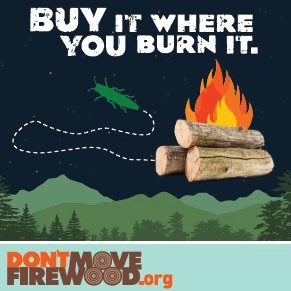
October is National Firewood Awareness Month, a good time to remind you that whether it’s for home heating or campfires, your firewood choices matter. Firewood can harbor tree-killing pests and diseases, some of which you may not be able to see outwardly right away.
This Firewood Awareness Month, help protect the places you love by making safe firewood choices:
- Buy firewood near where you’ll burn it.
2. Buy certified firewood (look for a state or federal seal).
3. Gather firewood on-site when permitted.
Visit DontMoveFirewood.org to learn more about the importance of your firewood choices and to tune in to some great firewood webinars this month!
Make sure you follow Wisconsin’s firewood rules that apply to the movement of firewood into and/or within the state:
- Wisconsin prohibits the entry of uncertified firewood out of any areas that are under quarantine for regulated forest pests including Asian longhorned beetle, spongy moth, and mountain pine beetle.
- State and federal authorities prohibit the export of uncertified firewood out of areas within Wisconsin that are quarantined for spongy moth.
- The Wisconsin DNR’s permanent rule prohibits the entry of uncertified firewood onto Department-owned properties if it originated more than 10 miles from the property or comes from an area infested with spongy moth.
Campgrounds often have additional restrictions on the use or movement of firewood. For example, Chequamegon-Nicolet National Forest prohibits the possession, storage, or transport of uncertified firewood that originates more than 25 miles from your campsite. Also, if moving firewood into or through Tribal properties, contact the tribe for their policies.
To protect forest resources from harmful pests, find out the rules at your destination before bringing firewood and visit Wisconsin’s Firewood Rules and Resources page for state-wide details. When in doubt, buy it where you burn it!
To find local firewood vendors in Wisconsin, visit Firewood Scout or Certified Firewood Dealers in Wisconsin.
Contact DATCP’s Forest Pest Regulatory Coordinator, Meg Sanders, with your firewood questions. Call or text Meg at (715) 891-8158 or email MeganT.Sanders@wisconsin.gov.
|
_____________________________________
|
|
|
2024 Box Tree Moth trap set at a production nursery in southeastern Wisconsin | DATCP S. Jentz
The North American trade of ornamental boxwood is under threat from the invasive box tree moth (BTM), which is rapidly expanding to new areas through the movement of infested boxwood plants and via natural spread (up to three to six miles per year naturally). The insect feeds on and destroys boxwoods, which are the largest-selling evergreen shrub in the U.S. BTM was first detected in the U.S. in New York in 2021. With recent detections in Pennsylvania, Michigan, and Ohio, and known boxwood imports from these states, surveillance for box tree moth in Wisconsin has become especially important for protecting the market for boxwood, as well as our nursery and landscape industries, and contributing data on the current status of BTM in North America.
DATCP’s Pest Survey Program conducted surveys for BTM for the first time in 2024, setting traps at five nurseries that grow or import boxwood for public or wholesale purchase in southeastern Wisconsin. A total of nine traps were deployed from mid-June through mid-September. The survey spanned five southeastern Wisconsin counties. All samples have been processed and no box tree moths were detected in 2024. DATCP plans to continue this survey in 2025, expanding trapping efforts to 10 locations across five counties.
Early detection is key to preventing significant damage, loss, and spread of box tree moths. If you suspect this insect on your boxwoods, please report it to your local nursery inspector or call the Pest Hotline at (866) 440-7523 or email a photo and your location to datcppesthotline@wisconsin.gov.
_____________________________________
|
|
|
2024 Spongy Moth Trap Catches | DATCP A. Miller
In 2024, the Wisconsin Spongy Moth Program set 8,921 traps in 44 counties spanning from central to western Wisconsin. Please note that this update includes preliminary data as final counts are still being verified.
The estimated total of statewide male spongy moth catches this year is 213,623, which is approximately half as many moths as were caught last year. The majority of these trap catches were recorded in the central and eastern parts of the state that have historically experienced spongy moth infestations. This year’s decrease indicates the first relief from an outbreak that had been building since an exceptionally low population in 2019 and peaked with record high moth catches in 2023. Such outbreaks typically occur every 10 years in areas where spongy moth is established and usually persist for two to four consecutive years before populations collapse. The unusually wet spring, combined with large caterpillar populations, provided the right conditions for widespread caterpillar mortality in 2024 due to naturally occurring fungal and virus controls - Entomophaga maimaiga and nuclear polyhedrosis virus (NPV), respectively.
Follow-up egg mass surveys are scheduled for fall 2024 to help determine whether unusually high trap counts in historically uninfested areas reflect the westward spread of persistent populations or rather a spillover of transient male moths from more heavily infested areas to the east.
_____________________________________
|
|
|
Spotted Lanternfly adults on grapes | Erica Smyers, Penn State
Spotted lanternfly (SLF, Lycorma delicatula) is an invasive insect that has the potential to disrupt local ecosystems and agricultural practices by feeding on plants such as walnut, grape, maple, and hops. It is not known to be in Wisconsin yet but is established in nearby states. It is crucial to keep an eye out and report any sightings of this pest to help contain a new population before it becomes established.
SLF egg masses | Emelie Swackhamer, Penn State University, Bugwood.org (left) and Kenneth R. Law, USDA APHIS PPQ, Bugwood.org (right)
With autumn now in full swing and leaves beginning to fall, it is time to be on the lookout for spotted lanternfly egg masses. In late summer, females lay their eggs in greyish, mud-like masses on various surfaces, including tree bark, stones, vehicles, and outdoor furniture, making it easy for this pest to spread to new areas. These egg masses are usually about one inch long and coated with a waxy, putty-like substance. As time passes, the covering deteriorates, exposing 30 to 60 eggs neatly arranged in several stacked rows.
From left to right: spongy moth egg mass, tussock moth egg mass, lichen | DATCP images
Common lookalikes include egg masses from spongy and tussock moths, lichen, and even mud. Unlike spotted lanternfly’s raised and waxy egg masses, spongy and tussock moth egg masses feel soft and squishy, while lichen and mud tend to be flat and brittle.
For more information on this pest or to report a sighting, visit slf.wi.gov.
Brief Update on 2024 SLF Surveys
DATCP continues preemptive detection work for the invasive spotted lanternfly (SLF) in 2024. This year, the Forest Pest Survey team has conducted a total of 70 visual surveys in 13 counties along the perimeter of high-risk introduction pathways (i.e. railyards, warehouses) or as follow-up responses to sightings reported by members of the public. Tree-of-heaven, the primary host of SLF, was simultaneously searched for and mapped. In total, staff walked over 50 miles in search of this pest, with no live SLF found to date.
_____________________________________
|
|
|
Nov. 19, 2024: IPM for Arborists and Foresters
Dec. 10, 2024: Deadly Oak Diseases
Jan. 14, 2025: Trees for Bees and Other Pollinators
Jan. 28, 2025: Reducing Pests in Schools Through IPM
Feb. 11, 2025: IPM for Four Key Greenhouse Pests
Feb. 26, 2025: Getting to the Root of the Problem: Myths About Urban Trees and Soil
Mar. 19, 2025: Picking Up Ticks: New Threats, Precautions and IPM Solutions
April 22, 2025: Promoting Pollinators Through Plant Selection
May 13, 2025: Protecting the Public from Illegal and Unregistered Pesticides
_____________________________________
|
|
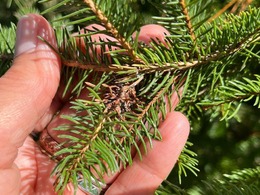 Eastern spruce gall adelgid on spruce in Price Co. | DATCP M. Wensing
|
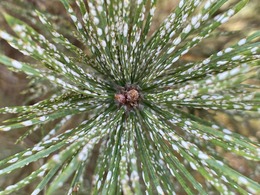 Heavy pine needle scale on scotch pine in Marquette Co. and throughout the state | DATCP L. Meils
|
|
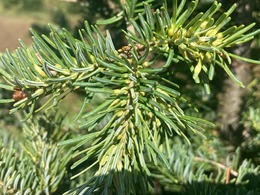 Balsam gall midge on balsam fir in Price Co. and throughout the northern counties | DATCP T. Boyle
|
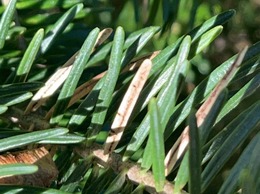 Lirula needle blight on fir in Price Co. | DATCP J. Oestreich
|
|
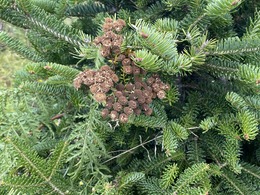 NR40 invasive tansy going to seed in Ch. tree field in Taylor Co. | DATCP L. Meils
|
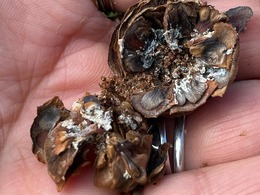 Frass and feeding damage from fir coneworm on fraser fir in Taylor Co. | DATCP M. Wensing
|
|
|
_____________________________________
|
|
|
|
|